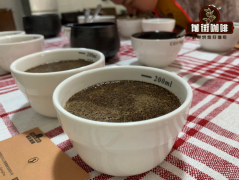Diversity of Colombian refined coffee varieties Colombia's natural diversity can prevent coffee pests
More than 50 per cent of Colombia is natural forest. It has 55,000 species of plants and animals. According to the Financial Times, 10 percent of the world's biodiversity can be found in the Amazon region of Colombia. The biodiversity of Colombia is astounding. You can taste it in every cup of coffee.
But these are not just impressive facts. They are also part of the reason why my country produces good coffee. It shapes flavor characteristics. It can even prevent pests.
Climate in Colombia
As the gateway to South America, Colombia's coast is kissed by the Pacific and Atlantic oceans. More importantly, there are plenty of inland waters. The Andes range runs from south to north along the western part of the country, making it mountainous. As a tropical country, Colombia has no seasons. Temperature depends only on altitude: the higher the altitude, the colder the weather. This unique geography means that the country has 314 ecosystems. This gives coffee a wider variety, which means there are plenty of birds, plants and animals that can help it grow well.
Coffee in Colombia
Coffee is an important source of income for the Colombia economy. In fact, according to The Economist, it is the fifth-largest source of foreign exchange earnings. It grows between 900 and nearly 3,000 masl-sometimes even beyond those ranges. In such a biodiversity-rich country, it coexists with wildlife, livestock and more crops such as tropical fruits, sugar cane, cocoa and bananas.
Despite the risk of pests, this diversity can help it grow organically.

Biodiversity: Natural insect repellents
Coffee borer beetle, Broca, has caused damage to coffee crops around the world. It crawls into coffee cherries to lay eggs. Then, once the eggs hatch, the larvae eat the cherries and destroy the beans.
However, if farmers produce shade-grown coffee at about 21 degrees Celsius (1,300 masl on average), then they can use the microscopic fungus Beauveria bassiana. It spreads through the natural moisture of forests and kills insects by attacking their respiratory systems. It's a way to fight coffee borers without endangering consumers 'and farmers' health or ecosystems.
Similarly, aromatic plants are natural insect repellents for crickets and beetles, both of which like to eat young coffee trees.
More benefits of growing coffee in forests
Most importantly, growing coffee in forests can provide useful nutrients to the soil, such as nitrogen, and even provide an additional source of income, such as fruit.
In Yalí, Antioquia Department, northwest of Colombia, you will come to Finca San Gabriel. This farm is located at 1,200 masl and benefits from forests. Coffee trees are protected by shade and high humidity. In addition, the temperature drops by about 16 degrees Celsius at night, causing cherries to be sweeter.
When the weather is dry, you'll see monkeys coming to the land to eat guava, a sweet tropical fruit whose trees are home to ants, termites, worms, millions of bugs, birds, and even small mammals. You can also discover some of the more than 1,900 species of birds and drink our bird-loving coffee. Colombia has more than 1,900 bird species, and if you want to spend a quiet time in the countryside of Colombia, I suggest you close your eyes first. Listen to the millions of sounds made by wind, grass, trees, insects and birds. Smell the sweet aroma of fruit and flowers, coupled with moist soil. The biodiversity of Colombia is astounding.
Important Notice :
前街咖啡 FrontStreet Coffee has moved to new addredd:
FrontStreet Coffee Address: 315,Donghua East Road,GuangZhou
Tel:020 38364473
- Prev

What are the main varieties of Chinese coffee? is the quality of Chinese coffee constantly improving?
Until recently, most coffee grown in China was known for its low price and generally low quality. It is mainly exported to the world through companies such as Starbucks and Nestl é. Over the past decade, however, smaller Chinese coffee farms have not only begun to produce better quality coffee, but have also become more sustainable. Nowadays, Yunnan coffee tends to have remarkable sweetness and unique taste.
- Next

Coffee cup test detailed process introduction coffee cup test steps analysis coffee cup test preparation
Being able to understand the flavor characteristics of coffee not only looks impressive. It can also improve the enjoyment of coffee. Although it seems impossible to distinguish the flavor characteristics at first, it is actually easy to train the taste of coffee. Like anything, practice makes perfect. The more we come into contact with the different flavors and properties of coffee, the better.
Related
- What brand of black coffee is the most authentic and delicious? what are the characteristics of the flavor of the authentic Rose Summer Black Coffee?
- Introduction to the principle and characteristics of the correct use of mocha pot A detailed course of mocha pot brewing coffee is described in five steps.
- Which is better, decaf or regular coffee? how is decaf made?
- How much is a bag of four cat coffee?
- How about four Cat Coffee or Nestle Coffee? why is it a cheap scam?
- Which is better, Yunnan four Cats Coffee or Nestle Coffee? How about cat coffee? is it a fake scam? why is it so cheap?
- How about Cat Coffee? what grade is a hoax? which instant coffee tastes better, four Cat Coffee, Nestle Coffee or G7 coffee?
- Process flow chart of coffee making-Starbucks coffee making process what coffee tastes good at Starbucks
- The top ten best coffee beans in the world Rose summer coffee or Tanzanian coffee tastes good
- Yunnan four cat coffee is good to drink?_four cat coffee is a big brand? four cat blue mountain coffee is fake?

